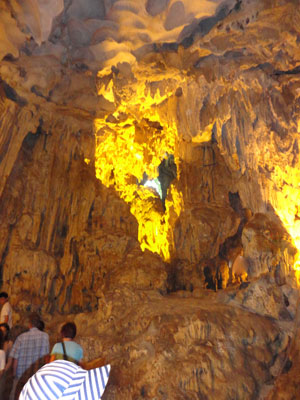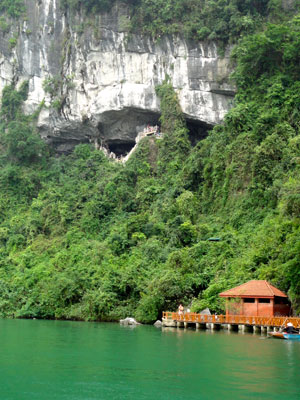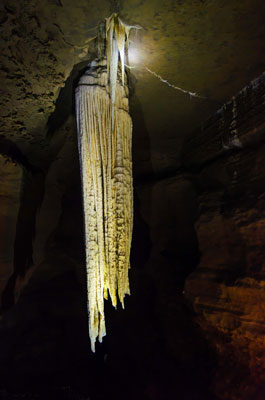Natural caves worth visiting
We asked subscribers to write in about any impressive, fascinating, historical or memorable natural caves worth visiting that are outside of the USA. Your letter was to include the cave’s name and location (contact info or general directions) and when you were there. In addition to describing the place and telling what you found noteworthy about it, we wanted to know how accessible it was plus any visitor restrictions or requirements, the best time to visit, any entry fee, etc., and about interesting sights nearby.
We’re printing a number of responses this month and next. If you have a site to add, write to Natural Caves Worth Visiting, c/o ITN, 2116 28th St., Sacramento, CA 95818, or e-mail editor@intltravelnews.com. Include the complete address at which you receive ITN (ITN prints letters from subscribers only). Pictures are always welcome; remember to include a full caption for each plus photo credit.
Of the hundreds of caves my wife, Betty, and I have visited, there is one approaching the caliber of Carlsbad Caverns in New Mexico. Located rather remotely in the ITALIAN province of Puglia, it is called Grotte di Castellana (Piazzale Anelli, 70013, Castellana Grotte, Province of Bari, Italy; phone +39 080 499 8221), and it’s near Alberobello, which is famous for its trulli houses.
The caves have convenient visiting hours and an excellent elevator. The prices are €10 (near $13) for the short tour and €15 for the long tour. I would recommend the long tour (1¾ miles), as it takes you to a room with more than 15,000 pure-white stalagmites. Stunning!
Also in the neighborhood and worth visiting, besides the intriguing trulli houses, are Ostuni, Bari (with its thousands of olive trees) and the beautiful Baroque city of Lecce. We were there in August 2005.
• Another cave worth mentioning, because it’s so different, is one located 40 kilometers south of Salzburg, AUSTRIA, on the A10 freeway. Called Eisriesenwelt (Eishoehlenstrasse 30, A-5450 Werfen, Austria; phone ++43 [0] 6468/5248), it is the largest ice cave in the world.
The road up to the cable station has spectacular views, then you take the cable car to the cave’s entrance. At over one mile in altitude, this cave is more than 25 miles long. It has ice all year long, but it’s closed in winter. The admission price, with the cable car ride, is now €20. The tour, including the time it takes to go from the bottom cable car station round trip, takes about 2½ hours. We visited about 10 years ago.
• Also nearby, about 20 kilometers south of Salzburg, is the Hallein Salt Mine (Salzwelten Bad Dürrnberg, Ramsaustraße 3, A-5422 Bad Dürrnberg, AUSTRIA; phone 0043 [0] 6132 200 8511). They equip you with mining overalls and hard hats, then you travel by miners’ train into the cave. Farther down, you can go on a slide which is for all ages.
Jim Doerksen, Santa Rosa, CA
My wife, Susan, and I stayed in the wonderful town of Werfen, AUSTRIA, many years ago on an Untour vacation.
In addition to Festung Hohensalzburg, the castle where the Clint Eastwood movie “Where Eagles Dare” was filmed, in Werfen there is Eisriesenwelt, or World of the Ice Giants, a naturally formed limestone cave that extends for 42 kilometers, making it the largest ice cave in the world.
Open only in the summer, the cave has amazing natural ice formations. Visitors were admitted only to the first kilometer of the cave, but that portion was amazing in the beautiful ice formations on display.
Getting there was a somewhat strenuous endeavor. From the car park, we walked uphill about 20 minutes to a cable car, took the cable car, then walked uphill another 20 minutes to the mouth of the cave.
Inside the cave it was, of course, cold. There were wooden stairs and walkways, but, as with many things Austrian, we had to be ready to walk, climb and be able to move with confidence over wet and rocky surfaces. My wife enjoyed the ice cave and then gave birth to our daughter 10 days later, so you might be able to gauge your relative abilities.
The cave was formed over millennia as the Salzach River flowed through the limestone. Anton Posselt, a natural scientist from Salzburg, explored it in 1879 and wrote about it in various publications. Before that, the cave was thought to be the entrance to Hell, and the locals refused to explore it.
Approximately 200,000 people visit the cave each year. It’s definitely worth visiting.
Wayne Elseth, Woodbine, MD
Sung Sot Cave can be found on Bo Hon Island in Ha Long Bay, off of the east coast of northern VIETNAM. My husband, Colin, and I were on an overnight cruise with Indochina Sails (27A6 Dam Trau, Hanoi, Vietnam; phone +84 4 3984 2362, fax 3984 4150) when we visited on Nov. 5, 2012.
There were about 20 passengers on the boat. After disembarking at the sea-level dock, we had a climb of about 100 steps to the first cave. Taken slowly, it was not too difficult, and the views of Ha Long Bay were amazing.
Within the cave, there were several chambers containing stalactites and limestone formations. A narrow passage led visitors into a larger expanse, with paved pathways leading through the cave system.
There was an admittance fee, but ours was covered as part of our cruise package. The steps and walkways through the cave could be crowded, but the lines moved steadily. There were many photo opportunities both within the cave and on the steps going up and down.
This was part of a private tour that we booked through American Express Vacations (800/335-3342). It was their recommendation that we use AAvan Vacation (Rosemead, CA; 800/240-5609) to make our arrangements, which included those with Indochina Sails. We met with a person from AAvan and settled on an itinerary.
Our travels in Asia actually began with a 17-day group tour of China with Tauck Tours, ending in Beijing, then we began our separate, 17-day private tour of Vietnam, Laos and Cambodia. For the two of us, the base fare of that was $5,538, with airfare another $2,004.
We flew in business class from Beijing to Hanoi and also took four flights (coach) within the three countries, returning home from Phnom Penh. At each city visited we had the services of a driver and guide, and at Ha Long Bay we boarded the Indochina Sails boat, disembarking 24 hours later.
We were not entirely satisfied with AAvan Vacation’s choice of flight times within the countries (inconvenient, with many hours wasted), accommodations were not up to the 3-star quality we anticipated, and a drive across Vietnam and Laos was grueling. On the positive side, the guides, drivers and air-conditioned cars all were great.
We enjoyed our cruise package with Indochina Sails, which began with lunch, followed by cruising the bays and stops at several islands, one to take a canoe ride to see a monkey colony and another to climb Dao Ti Top (Ti Top Island) for the sunset. We also had a chance to swim in the bay.
Back on board, we had dinner and spent the night. In the morning, after a Tai Chi class, we took a ferry to Sung Sot Cave, then returned to the boat for breakfast before heading back to Ha Long City, where we rejoined our driver.
Ethel Brodie, Discovery Bay, CA
Neither my wife nor I are cave people, particularly, though we loved the Font-de-Gaume, the prehistoric cave in the Dordogne region of France, about 25 years ago. So imagine how surprised we were to be really fascinated by the one-hour-or-so experience of smoothly sailing on a river through the Waitomo Glowworm Caves (39 Waitomo Caves Rd., Waitomo Caves, Private Bag 501, Otorohanga, NEW ZEALAND; phone +6478788228).
In the glowworm caves, there were thousands of these tiny creatures radiating their luminescent light as our guide provided informative commentary on the caves’ historical and geological significance.
Waitomo is about 2½ hours’ drive south of Auckland. We visited along with another couple in January ’13. Our admission vouchers cost about NZD48 (near $38.50). The wait was minimal, 10 to 15 minutes.
Paul Kastin, Atlanta, GA
On a 2-week driving trip in IRELAND in June of 2012, my wife, Kathy, and I and another couple went from Dingle to Doolin, where we had planned a night’s stay at a B&B in order to visit the Cliffs of Moher the next morning. The cliffs are a 10-minute drive from the village.
When in Doolin, don’t miss McDermott’s Bar & Restaurant (phone +353 65 7074328), especially in “football” season.
Arriving at the B&B a bit early, we looked for something to do before checking in. Doolin Cave (Doolin, Co. Clare, Ireland; phone +353 65 7075761) popped up as a possibility and, its being only five minutes’ drive from Doolin, it was easy to check out.
We found an inauspicious but clean reception facility with friendly staff. From there, we were taken by a guide down 80 or so steps to the cave level, then along a narrow and low tunnel to the cave, proper.
The main attraction is a stalactite of tremendous size. Neither my picture nor any of those online give due justice to its size.
I will spare you the story of how the cave was discovered, since the guides do a much better job. It is fascinating, however.
At 78, climbing back up the steps was a challenge but doable.
Doolin Cave is certainly worth a visit, especially for those who normally don’t do caves. There was a charge of about €15 (near $20) for adults. The website gives all the particulars, such as directions, seasonal opening and hours.
Brantley Thomas, Wando, SC
I don’t like caves. I suppose I have a touch of claustrophobia. Though I’m not frightened within, I just rather dislike the whole thing.
Our daughter emigrated to western IRELAND in 1987, and we have been over to visit most years since. It would have been almost impossible to avoid the rocky landscape of the Burren in the northwest of county Clare, just south of Galway, and it rapidly became a favorite locale. All trips to Ireland have included a meandery drive or two around the barren but somehow delightful scenery of the virtually treeless Burren.
It was about 2008 when said daughter announced firmly that I should see Aillwee Cave (Ballyvaghan, Co. Clare, Ireland; phone +353 65 707 7036).
“I know you don’t like caves,” she said, “but they have done such a good job of opening it up for tourists. I think you’d be interested.”
She was quite right. The guide described much of the process of achieving accessibility for visitors and, quite simply, she was enthusiastic enough to make the tour an experience I recall with pleasure.
It seems to me that the tour lasted 30 to 45 minutes. I have a troublesome back and travel with a cane, but I had no trouble negotiating the walk. It would, however, have been quite impossible for someone in a wheelchair.
Aillwee is certainly not “hidden away.” Their website calls it 40 minutes from Galway and 40 minutes from Shannon airport. That’s a bit optimistic but not a wild exaggeration. It is a 20- to 30-minute drive east of the Cliffs of Moher, one of Ireland’s most famous sights. Aillwee really couldn’t be easier to include on a trip to Ireland. Signs are posted for miles around; it would be hard not to find it.
Regular admission is €12 (near $16). The cave opens at 10 a.m., and closing time varies from 5 to 6:30, depending on the season.
• Serious spelunkers should be told that there is a viewable cave in nearby Doolin (to the west, sort of toward the Cliffs of Moher). I’m afraid I won’t be able to give a personal account, but I’m told Doolin Cave has some more spectacular features than Aillwee does.
May C. Targett, Cleveland, OH



